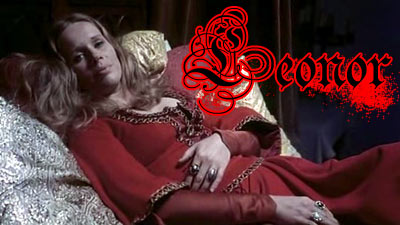
The film stars Michel Piccoli, one of Luis Buñuel's favorite actors, and Ingmar Bergman regular Liv Ullmann; the score was composed by Ennio Morricone, and the director of photography was Luciano Tovoli, who went on to do such a magnificent job with Suspiria. All in all, the film comes with a remarkable pedigree. It's hard to imagine a film like this falling into complete obscurity.
Yet in the United States, practically nobody's even heard of the movie. Those that have heard of it probably got their information from the old video movie guides of the 1990's, back when Leonor was available on VHS... and those video guides, all of them that I can remember (and I read them all compulsively), hated the movie. I think it was the Golden Video Retriever that called it "idiotic" and gave it a single star; but that sort of response is typical of the way mass-market reviewers in the US treated Leonor, when they bothered to mention it at all.
I haven't seen the U.S. video version of the film, but I can think of plenty of reasons why the reviewers might have formed such an unfavorable opinion. For instance, I know the film was cut by about 10 minutes; depending on where the cuts were made, this could make a serious difference in the flow of the narrative. Then, too, the video version was both dubbed into English and cropped; even when these things are done carefully, they can still change a movie for the worse. Furthermore, there's the matter of the movie's marketing: when it was released to American theaters in 1977 (two years after its original appearance), it was sold as yet another European rip-off of either The Exorcist (1974) or The Omen (1976). Though the Devil does appear in Leonor, the movie has nothing at all in common with either American blockbuster... but then again, by that late date, American audiences were getting sick of European rip-offs of The Exorcist; so the people who might have appreciated the film saw the poster and stayed home, while the others went to see it and left disappointed. Thus when the movie appeared on video a few years later, there wasn't much of a demand for it, and there weren't very many people around to speak up in its defense.
But I have a feeling the biggest problem the reviewers had was the false set of assumptions they brought to the movie when they found out who directed it: Juan Luis Buñuel, the son of the great Spanish director Luis Buñuel. Now, the elder Buñuel is acknowledged all over the world as one of the greatest directors of all time: a fiercely uncompromising artist whose movies made a scathing attack on conventional religious, social and political attitudes. On the other hand, Buñuel fils has always been comfortable working in purely commercial genres, including horror... much to the disgust of many "serious-minded" critics, who expected him to carry on in his father's footsteps. Thus so many of those capsule reviews I've mentioned not only trash the movie, but also go out of their way to trash the younger Buñuel as the great director's "far less talented" son.
Well, the old video guides have it all wrong. Leonor is one of the most deeply moving films ever to appear (at least nominally) in the horror genre. What "horror" is to be found in it springs entirely from the characters and their relationships — there is very little in the way of special effects or on-screen violence; and rather than relying on darkness and shadows to create an atmosphere of dread, most of the movie is shot in brilliantly clear daylight. And yet it is a horror film — specifically, it is a vampire film; more than that, it is the vampire film for people like me, who are sick to undeath of vampire films in general.
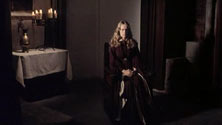
We are not told when Leonor is supposed to take place, but the events of the movie date the start of the action to the early 1340s. Michel Piccoli plays Richard, the lord of a medieval manor. When we first see Richard, he is returning from the treacherous journey to the City, where he has gone to fetch a physician for his wife, Leonor. Leonor had been thrown from her horse and grievously injured; now Richard is desperately anxious to return to her, allowing nothing — not even an attack by brigands — to stand in his way.
Leonor is still unconscious as Richard returns. The doctor takes one look at her condition and pronounces it very grave indeed. In fact, her injury is probably beyond the capability of 21st century medicine to deal with, let alone that of the fourteenth. But the doctor is determined to try. Pulling out a gruesome wooden prop, he attempts to explain to Richard what he thinks is wrong, using the latest (yet none-too-accurate) theories on anatomy and physick. It's then that Richard's faithful castellan, Thomas, recognizes the doctor: isn't he the same physician he'd seen in San Martino seven years before, offering the same explanation to the family of a child who was seriously ill? And hadn't he then proceeded to vivisect the poor child, who died in agony?
There's a proverb that says that to a man with a hammer, every problem looks like a nail. And the physician is a man with a knife. But in spite of Thomas's misgivings, Richard has no choice but to trust the doctor, for the only alternative is to do nothing at all. So Richard leaves the doctor to his work, which begins with the all-too-common ancient medical practice of bloodletting.
And although Leonor is a vampire movie, this thin trickle of blood — from Leonor herself, dripping slowly into a bowl by her bedside — is the only human blood we see on-screen.
The only non-human blood we see comes in the following scene: Richard, wild with frustration, decides to kill the horse that threw her (though mercifully, he does this off-screen). He emerges from the stables with his bloody sword and trudges back to the castle, but falls to his knees in anguish at the threshold, unable to enter.
We next see Richard sitting disconsolately over a meal that seems to have turned to dust in his mouth. Gradually we realize what must have happened, as the camera begins a slow pan across the room to reveal... the bier of Leonor: unsurprisingly, fourteenth century medicine has proved unequal to the task.
Richard's servants then carry the bier off to the family vault. So heartbroken is Richard over Leonor's death that he orders the vault bricked up forever, shutting her off from his memory as though she had never existed. In fact, the servants can't seal up the tomb fast enough; Richard tears off his cape with a snarl and forces them out of the way, so he can finish the job with his own hands.
After the tomb has been walled up, and his official period of mourning has ended, Richard rides off into the village. There he goes to call on one of his most prosperous vassals, who has a beautiful young daughter named Catherine (the waifish, twenty-year-old Ornella Muti — a natural choice for a character who must age convincingly from about 12 to 22 over the course of the film). Richard announces that he has decided to take Catherine for his next wife. The poor girl's father is shocked: he tries to point out that the girl is still very young (though not unreasonably young, as 12 was considered mature for the era); then, recognizing that Richard is still half-mad with grief, he suggests the ceremonies be postponed just a little. But in the end, the Lord of the manor has his way. And of course, this just makes everybody miserable — especially Richard: with each of his attempts to build a new life, he becomes more and more aware of Leonor's absence.
At one of his lowest points, on one of his many solitary rides through the hostile countryside, he stops at a bridge overlooking a mountain chasm and offers a bargain to the Devil. He'll trade his soul to regain the happiness he knew with Leonor. But his bargain is answered only by the wind; so Richard returns home to get married again.
Years pass (it is now about 1348), and Richard is visibly aged — but nothing has eased the bitterness in his heart. A spirited gathering of old friends turns somber: first, one man recalls his recent travels in Italy, and describes how a terrible plague had begun to spread there. The disease laid waste to entire cities, he says, and filled the air with the stench of death. Afterwards, the men have too much to drink, and Richard's existential despair comes welling up in a fit of senseless violence and vandalism.
The first (and only) sign we get that Richard may be able to grow out of his agony comes when he and Catherine are alone together, tending to a flock of sheep. In an unguarded moment, Richard looks up and catches sight of his young wife holding a lamb in her arms; and for the first time, he sees her as a real woman — another warm, living human being, with whom he might be able to find a new happiness. In a remarkably captured moment, he takes her in his arms, and the two of them sink to the floor as the animals mill around them, bleating.
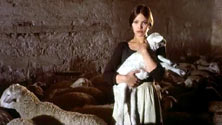
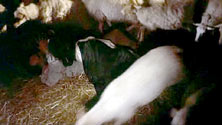
By this time, Catherine has given him two sons; but one day, as he watches over his sleeping boys, the memory of Leonor comes back to him so vividly that for a moment, he thinks he sees her standing by a riverbank. After this, Richard withdraws still further — he abandons Catherine's bed and moves into Leonor's long-abandoned room. Unable to sleep in his misery, he takes to hacking up logs with his broadsword, just to exhaust himself enough to rest.
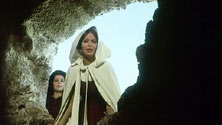
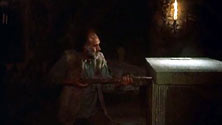
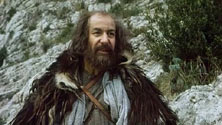
The emergence of the undead monster from the grave is usually a high point of any horror film. Film-makers and audiences alike seem to relish the scenes of bony hands pushing back the lids of stone sarcophagi, or clawing their way out of the soil. But Leonor is not a typical horror film: Leonor's rise from the grave is shot in the simplest and least exploitative way imaginable. One moment the Devil is standing by the sarcophagus, as an unearthly wind begins to blow through the crypt; Richard shields his eyes for a moment, and when he looks back, the tomb is open, and his beloved Leonor is walking unsteadily toward him...
This is where the movie really starts to come into its own. Richard is both overjoyed and horrified that his love has been restored to him, but poor Leonor is simply bewildered. She has no idea where she is, or how she got there; and she is very cold. Then she sees how much Richard has changed: the grey in his beard, and the lines on his eyes... and Richard must inform her that she has been away from him for ten whole years. It's difficult enough for Leonor to accept that she has been sick for ten years — but then she catches sight of the empty tomb, and for the first time she understands what her "sickness" really was.

But it's important to note that Leonor doesn't know what she's become — at least not at first. And when she does start to find out, she is understandably reluctant to do what she must do. Through most of the rest of the movie, up until the very end, we are never completely sure how far into corruption Leonor has fallen at any point. We don't actually see her feeding; but we do sometimes see her with her victims, who are all children, and we experience with her the combined horror and hunger as she lures them to their deaths (though one girl she leaves alive suffers a cruel and typically Buñuellian fate, precisely because she survives... the overzealous village priest, as obvious a target for the younger Buñuel as for his father, determines that she must be a witch, and... and... well, let's say the Church finds an innovative use for some new technology).
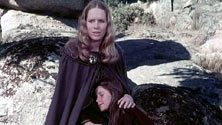
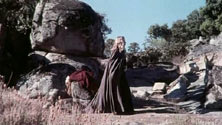
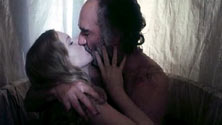
Though there are no scenes of Leonor biting throats, there are plenty of horrific images in the film that have nothing to do with the supernatural: from the ghastly, surreal execution of the "witch", to the harrowing consequences of the plague, to the scene in which the peasants attempt to catch Leonor by tying a little girl to a stake in the forest, like a tethered goat for a wild animal. Yet even amid the images of horror and impending doom, the movie's real strength is in its quieter moments. Many of these involve poor Thomas, who is torn between his loyalty to his Lord and Lady — and his genuine affection for them — and the knowledge that they have both become monsters. For example, there's a pointed conversation early in the film between Thomas and the priest about mice and serpents, which wouldn't be out of place in one of Buñuel's father's films (watch the background of the scene for its ironic conclusion). When Leonor first returns and Thomas is still reeling in shock, she turns to him and orders him to bring her perfume... strong perfume (shudder). Later, when Thomas hesitantly confesses his fear to Richard, and even later, when he makes his poignant farewell to his master, Thomas's simple humanity throws Richard's selfish and self-destructive passion into sharp contrast.
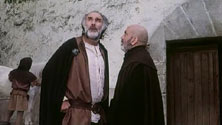
I think it should be clear by now that this is not a typical horror film, and that in spite of its central love story, it has nothing at all in common with the currently-popular "romantic vampire" subgenre. This is a film about adults, for adults. So how does it end, you wonder? Does Richard come to his senses and put a stake through the heart of his beloved? Do Leonor and the Devil suddenly find themselves in a night club in 20th century New York (oops! wrong Buñuel!)? Well... this should give you one more idea how far removed Leonor is from the average vampire flick: the actual dénouement is considered so unimportant that the end credits have already begun to roll as it starts.
Maybe it's so far removed from the expectations of the genre that it will never find a wide audience in the English-speaking world. Its release on Spanish DVD (ironically, as part of a series entitled "Essential Classics of Spanish Cinema") seems to have gone largely unheralded. But it certainly doesn't deserve the total neglect that it seems to have received.
Ennio Morricone's music is deserving of special mention: it's as crucial to the atmosphere of the film as the performances or the cinematography. The whole score is based on two deceptively simple melodies, one of which seems to represent the doomed love of Richard and Leonor, and the other of which is only heard when Leonor is absent. Both melodies flicker back and forth effortlessly between major and minor modes; it's difficult to describe their poignant, smiling-through-their-tears character in words. Have you ever watched as the light of the setting sun makes everything so radiantly beautiful for a few moments, and then — at first imperceptibly — begins to fade into shadow? Well, it's something like that.
Of course, if you're still not convinced that the son of the great Luis Buñuel should be sullying his family name with a mere vampire film, I should also point out that a classical Marxist reading of Leonor is ridiculously easy to imagine. All you need to do is to understand Richard's obsession with his lost love as an allegorical representation of the medieval landowner's (and by extension, the modern capitalist's) refusal to give way to the profound socio-political changes that we ere accelerated by the coming of the Black Death to the whole of Western Europe (for which you may read any major political or economic catastrophe from 1848 to the present day). Richard clings to the old system — even though it turns out to be detrimental to his own interests, and eventually brings about the collapse of the old regime. Similarly, the decision of the peasants to march to certain death, rather than be victimized by the predatory vampire that the old system has become, is as clear a call to revolution as any issued by Eisenstein.
If there's anything else I can do to persuade people to take notice of this movie — any more horse manure like the last paragraph I can shovel to attract the attention of the Serious Critics — then somebody, please let me know what it is; I'll do it. Unless, of course, it involves a shabbily-dressed man with a beard who appears in multiple places at once. I don't want it that badly....
